Review and Critique of Operations Management Principles in Cadbury
VerifiedAdded on 2023/04/20
|19
|5136
|453
AI Summary
This assessment analyzes the implementation of operations management principles in Cadbury and provides a continuous improvement plan. It discusses the principles of operations management, their application in Cadbury, and the need for continuous improvement.
Contribute Materials
Your contribution can guide someone’s learning journey. Share your
documents today.

Running head: ASSESSMENT
ASSESSMENT
Name of the Student
Name of the University
Author Note
ASSESSMENT
Name of the Student
Name of the University
Author Note
Secure Best Marks with AI Grader
Need help grading? Try our AI Grader for instant feedback on your assignments.

1ASSESSMENT
Table of Contents
Unit 16.............................................................................................................................................2
1. Conduct a review and critique of the implementation of operations management
principles within an organizational context................................................................................2
2. Prepare a continuous improvement plan based on the review and critique of
operations management principles within an organizational context......................................8
3. Apply each stage of the PLC to a given project, producing necessary supporting
documentation for completing the project e.g. a business case, project plan, work
breakdown structure...................................................................................................................10
4. Review and critique the effectiveness of the PLC in application to the chosen
project using appropriate theories, concepts and models........................................................14
Bibliography.................................................................................................................................17
Table of Contents
Unit 16.............................................................................................................................................2
1. Conduct a review and critique of the implementation of operations management
principles within an organizational context................................................................................2
2. Prepare a continuous improvement plan based on the review and critique of
operations management principles within an organizational context......................................8
3. Apply each stage of the PLC to a given project, producing necessary supporting
documentation for completing the project e.g. a business case, project plan, work
breakdown structure...................................................................................................................10
4. Review and critique the effectiveness of the PLC in application to the chosen
project using appropriate theories, concepts and models........................................................14
Bibliography.................................................................................................................................17
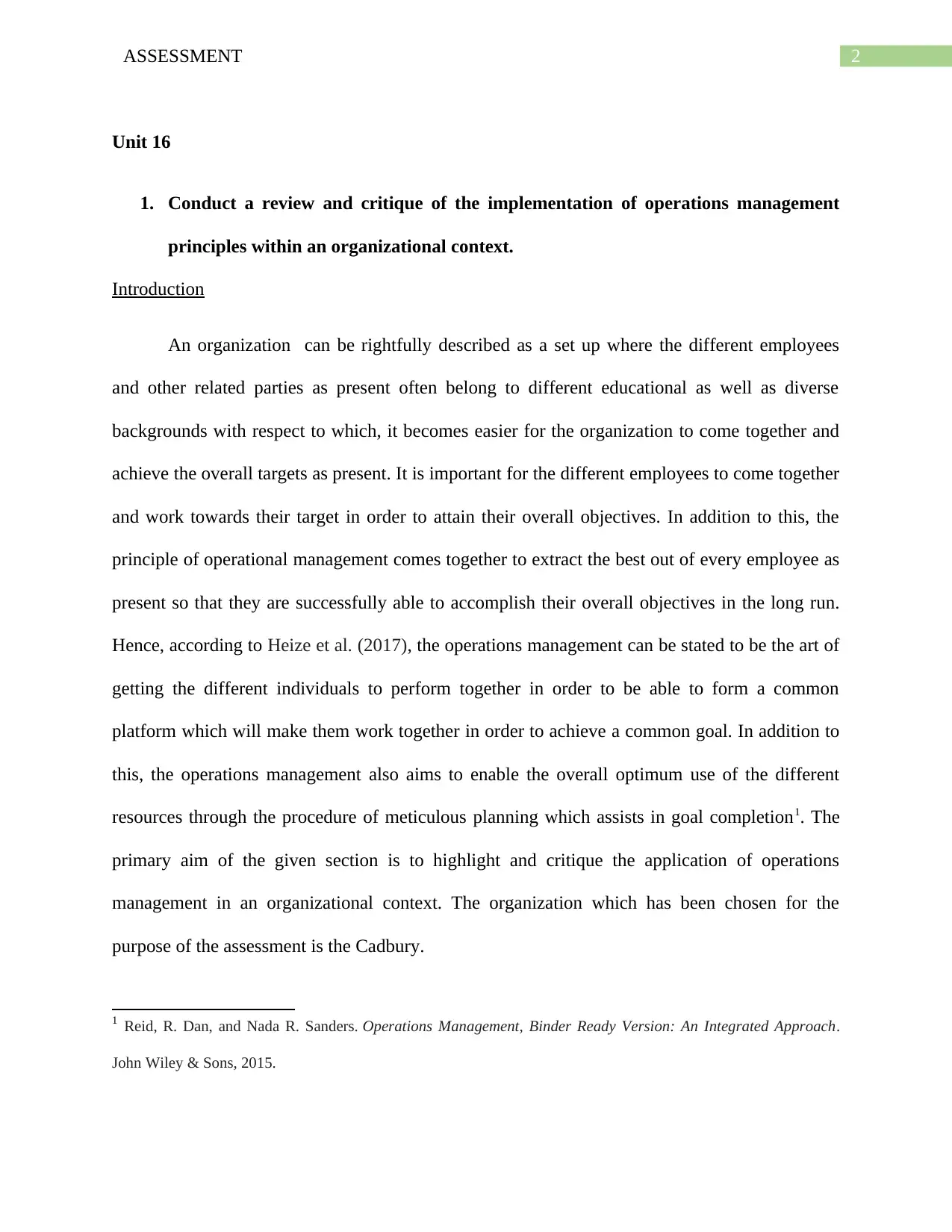
2ASSESSMENT
Unit 16
1. Conduct a review and critique of the implementation of operations management
principles within an organizational context.
Introduction
An organization can be rightfully described as a set up where the different employees
and other related parties as present often belong to different educational as well as diverse
backgrounds with respect to which, it becomes easier for the organization to come together and
achieve the overall targets as present. It is important for the different employees to come together
and work towards their target in order to attain their overall objectives. In addition to this, the
principle of operational management comes together to extract the best out of every employee as
present so that they are successfully able to accomplish their overall objectives in the long run.
Hence, according to Heize et al. (2017), the operations management can be stated to be the art of
getting the different individuals to perform together in order to be able to form a common
platform which will make them work together in order to achieve a common goal. In addition to
this, the operations management also aims to enable the overall optimum use of the different
resources through the procedure of meticulous planning which assists in goal completion1. The
primary aim of the given section is to highlight and critique the application of operations
management in an organizational context. The organization which has been chosen for the
purpose of the assessment is the Cadbury.
1 Reid, R. Dan, and Nada R. Sanders. Operations Management, Binder Ready Version: An Integrated Approach.
John Wiley & Sons, 2015.
Unit 16
1. Conduct a review and critique of the implementation of operations management
principles within an organizational context.
Introduction
An organization can be rightfully described as a set up where the different employees
and other related parties as present often belong to different educational as well as diverse
backgrounds with respect to which, it becomes easier for the organization to come together and
achieve the overall targets as present. It is important for the different employees to come together
and work towards their target in order to attain their overall objectives. In addition to this, the
principle of operational management comes together to extract the best out of every employee as
present so that they are successfully able to accomplish their overall objectives in the long run.
Hence, according to Heize et al. (2017), the operations management can be stated to be the art of
getting the different individuals to perform together in order to be able to form a common
platform which will make them work together in order to achieve a common goal. In addition to
this, the operations management also aims to enable the overall optimum use of the different
resources through the procedure of meticulous planning which assists in goal completion1. The
primary aim of the given section is to highlight and critique the application of operations
management in an organizational context. The organization which has been chosen for the
purpose of the assessment is the Cadbury.
1 Reid, R. Dan, and Nada R. Sanders. Operations Management, Binder Ready Version: An Integrated Approach.
John Wiley & Sons, 2015.
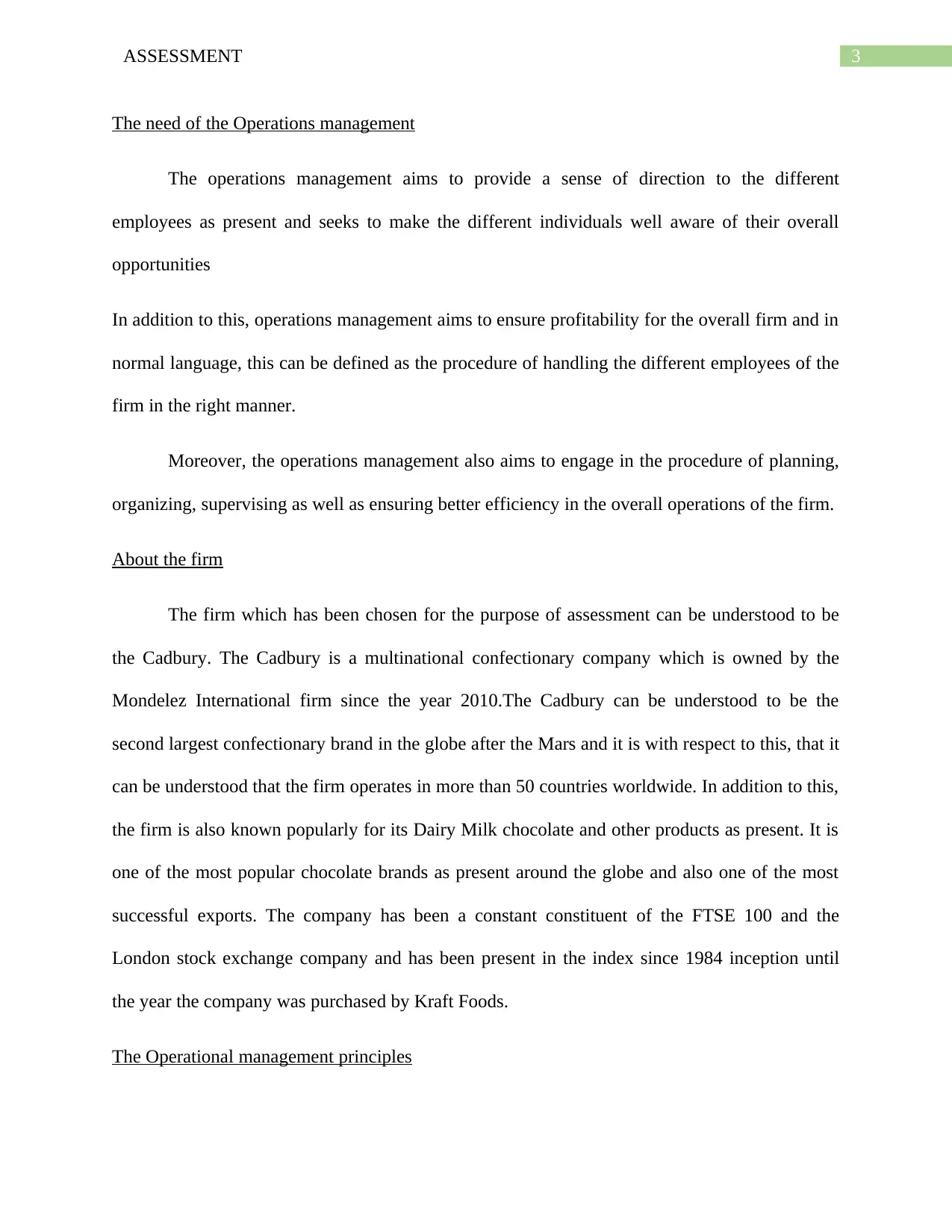
3ASSESSMENT
The need of the Operations management
The operations management aims to provide a sense of direction to the different
employees as present and seeks to make the different individuals well aware of their overall
opportunities
In addition to this, operations management aims to ensure profitability for the overall firm and in
normal language, this can be defined as the procedure of handling the different employees of the
firm in the right manner.
Moreover, the operations management also aims to engage in the procedure of planning,
organizing, supervising as well as ensuring better efficiency in the overall operations of the firm.
About the firm
The firm which has been chosen for the purpose of assessment can be understood to be
the Cadbury. The Cadbury is a multinational confectionary company which is owned by the
Mondelez International firm since the year 2010.The Cadbury can be understood to be the
second largest confectionary brand in the globe after the Mars and it is with respect to this, that it
can be understood that the firm operates in more than 50 countries worldwide. In addition to this,
the firm is also known popularly for its Dairy Milk chocolate and other products as present. It is
one of the most popular chocolate brands as present around the globe and also one of the most
successful exports. The company has been a constant constituent of the FTSE 100 and the
London stock exchange company and has been present in the index since 1984 inception until
the year the company was purchased by Kraft Foods.
The Operational management principles
The need of the Operations management
The operations management aims to provide a sense of direction to the different
employees as present and seeks to make the different individuals well aware of their overall
opportunities
In addition to this, operations management aims to ensure profitability for the overall firm and in
normal language, this can be defined as the procedure of handling the different employees of the
firm in the right manner.
Moreover, the operations management also aims to engage in the procedure of planning,
organizing, supervising as well as ensuring better efficiency in the overall operations of the firm.
About the firm
The firm which has been chosen for the purpose of assessment can be understood to be
the Cadbury. The Cadbury is a multinational confectionary company which is owned by the
Mondelez International firm since the year 2010.The Cadbury can be understood to be the
second largest confectionary brand in the globe after the Mars and it is with respect to this, that it
can be understood that the firm operates in more than 50 countries worldwide. In addition to this,
the firm is also known popularly for its Dairy Milk chocolate and other products as present. It is
one of the most popular chocolate brands as present around the globe and also one of the most
successful exports. The company has been a constant constituent of the FTSE 100 and the
London stock exchange company and has been present in the index since 1984 inception until
the year the company was purchased by Kraft Foods.
The Operational management principles
Paraphrase This Document
Need a fresh take? Get an instant paraphrase of this document with our AI Paraphraser
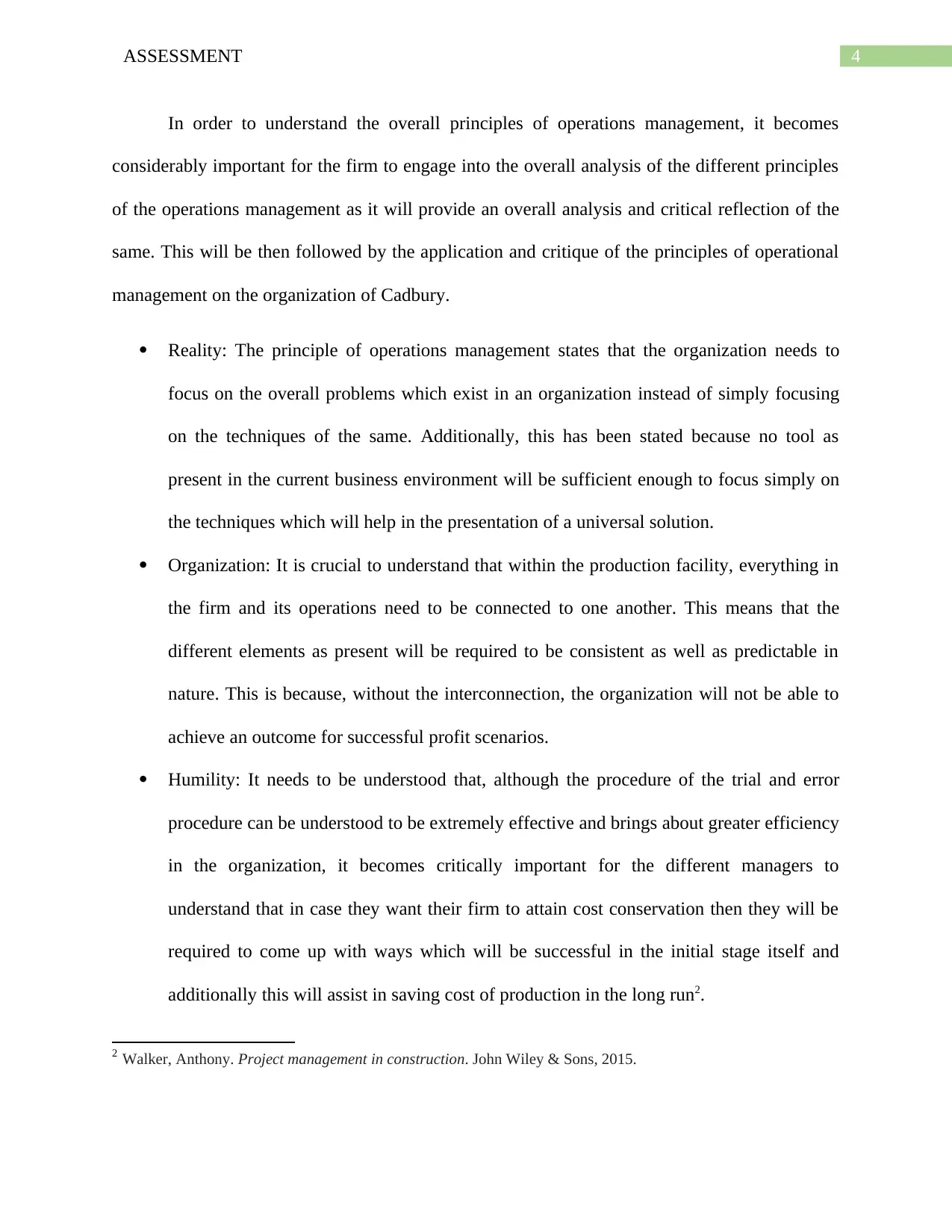
4ASSESSMENT
In order to understand the overall principles of operations management, it becomes
considerably important for the firm to engage into the overall analysis of the different principles
of the operations management as it will provide an overall analysis and critical reflection of the
same. This will be then followed by the application and critique of the principles of operational
management on the organization of Cadbury.
Reality: The principle of operations management states that the organization needs to
focus on the overall problems which exist in an organization instead of simply focusing
on the techniques of the same. Additionally, this has been stated because no tool as
present in the current business environment will be sufficient enough to focus simply on
the techniques which will help in the presentation of a universal solution.
Organization: It is crucial to understand that within the production facility, everything in
the firm and its operations need to be connected to one another. This means that the
different elements as present will be required to be consistent as well as predictable in
nature. This is because, without the interconnection, the organization will not be able to
achieve an outcome for successful profit scenarios.
Humility: It needs to be understood that, although the procedure of the trial and error
procedure can be understood to be extremely effective and brings about greater efficiency
in the organization, it becomes critically important for the different managers to
understand that in case they want their firm to attain cost conservation then they will be
required to come up with ways which will be successful in the initial stage itself and
additionally this will assist in saving cost of production in the long run2.
2 Walker, Anthony. Project management in construction. John Wiley & Sons, 2015.
In order to understand the overall principles of operations management, it becomes
considerably important for the firm to engage into the overall analysis of the different principles
of the operations management as it will provide an overall analysis and critical reflection of the
same. This will be then followed by the application and critique of the principles of operational
management on the organization of Cadbury.
Reality: The principle of operations management states that the organization needs to
focus on the overall problems which exist in an organization instead of simply focusing
on the techniques of the same. Additionally, this has been stated because no tool as
present in the current business environment will be sufficient enough to focus simply on
the techniques which will help in the presentation of a universal solution.
Organization: It is crucial to understand that within the production facility, everything in
the firm and its operations need to be connected to one another. This means that the
different elements as present will be required to be consistent as well as predictable in
nature. This is because, without the interconnection, the organization will not be able to
achieve an outcome for successful profit scenarios.
Humility: It needs to be understood that, although the procedure of the trial and error
procedure can be understood to be extremely effective and brings about greater efficiency
in the organization, it becomes critically important for the different managers to
understand that in case they want their firm to attain cost conservation then they will be
required to come up with ways which will be successful in the initial stage itself and
additionally this will assist in saving cost of production in the long run2.
2 Walker, Anthony. Project management in construction. John Wiley & Sons, 2015.
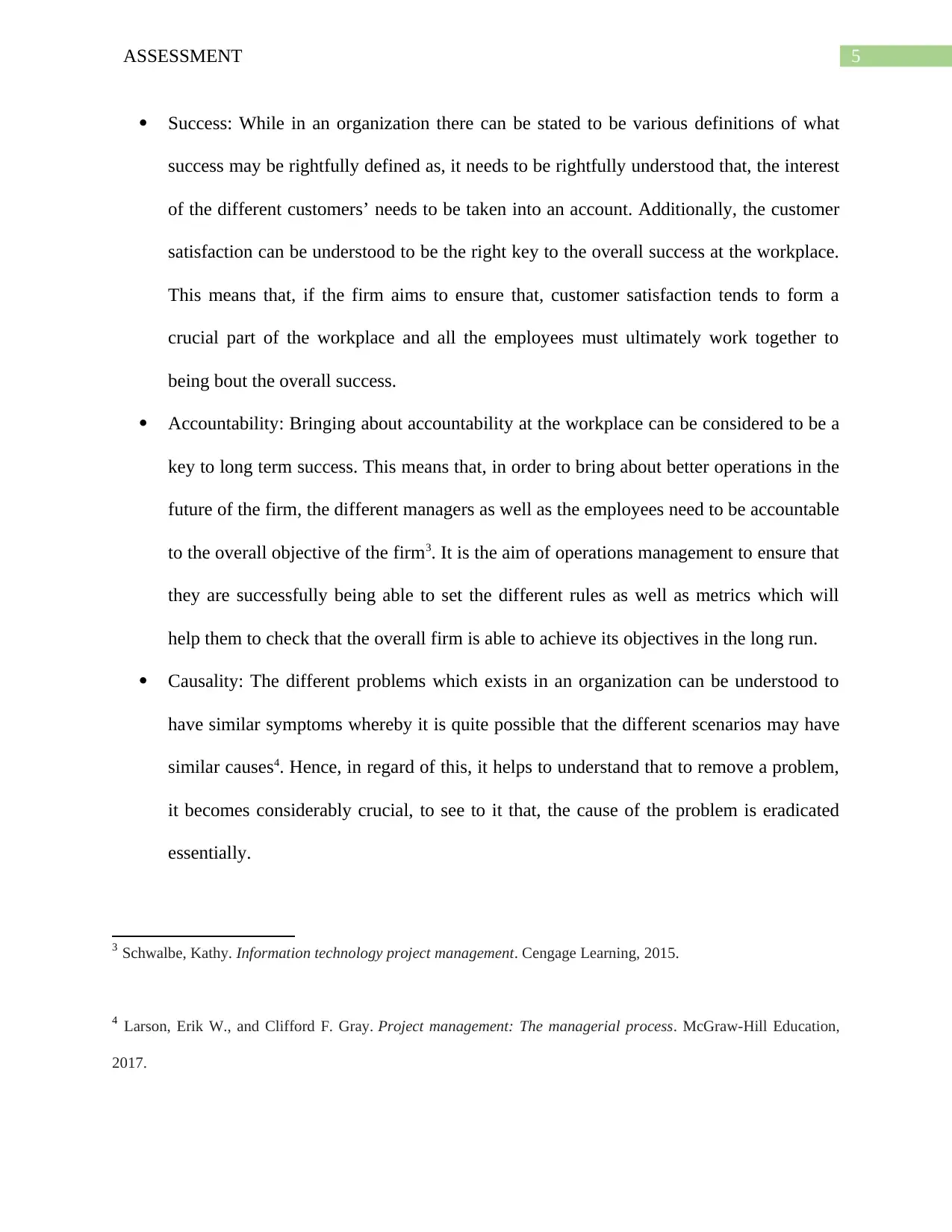
5ASSESSMENT
Success: While in an organization there can be stated to be various definitions of what
success may be rightfully defined as, it needs to be rightfully understood that, the interest
of the different customers’ needs to be taken into an account. Additionally, the customer
satisfaction can be understood to be the right key to the overall success at the workplace.
This means that, if the firm aims to ensure that, customer satisfaction tends to form a
crucial part of the workplace and all the employees must ultimately work together to
being bout the overall success.
Accountability: Bringing about accountability at the workplace can be considered to be a
key to long term success. This means that, in order to bring about better operations in the
future of the firm, the different managers as well as the employees need to be accountable
to the overall objective of the firm3. It is the aim of operations management to ensure that
they are successfully being able to set the different rules as well as metrics which will
help them to check that the overall firm is able to achieve its objectives in the long run.
Causality: The different problems which exists in an organization can be understood to
have similar symptoms whereby it is quite possible that the different scenarios may have
similar causes4. Hence, in regard of this, it helps to understand that to remove a problem,
it becomes considerably crucial, to see to it that, the cause of the problem is eradicated
essentially.
3 Schwalbe, Kathy. Information technology project management. Cengage Learning, 2015.
4 Larson, Erik W., and Clifford F. Gray. Project management: The managerial process. McGraw-Hill Education,
2017.
Success: While in an organization there can be stated to be various definitions of what
success may be rightfully defined as, it needs to be rightfully understood that, the interest
of the different customers’ needs to be taken into an account. Additionally, the customer
satisfaction can be understood to be the right key to the overall success at the workplace.
This means that, if the firm aims to ensure that, customer satisfaction tends to form a
crucial part of the workplace and all the employees must ultimately work together to
being bout the overall success.
Accountability: Bringing about accountability at the workplace can be considered to be a
key to long term success. This means that, in order to bring about better operations in the
future of the firm, the different managers as well as the employees need to be accountable
to the overall objective of the firm3. It is the aim of operations management to ensure that
they are successfully being able to set the different rules as well as metrics which will
help them to check that the overall firm is able to achieve its objectives in the long run.
Causality: The different problems which exists in an organization can be understood to
have similar symptoms whereby it is quite possible that the different scenarios may have
similar causes4. Hence, in regard of this, it helps to understand that to remove a problem,
it becomes considerably crucial, to see to it that, the cause of the problem is eradicated
essentially.
3 Schwalbe, Kathy. Information technology project management. Cengage Learning, 2015.
4 Larson, Erik W., and Clifford F. Gray. Project management: The managerial process. McGraw-Hill Education,
2017.
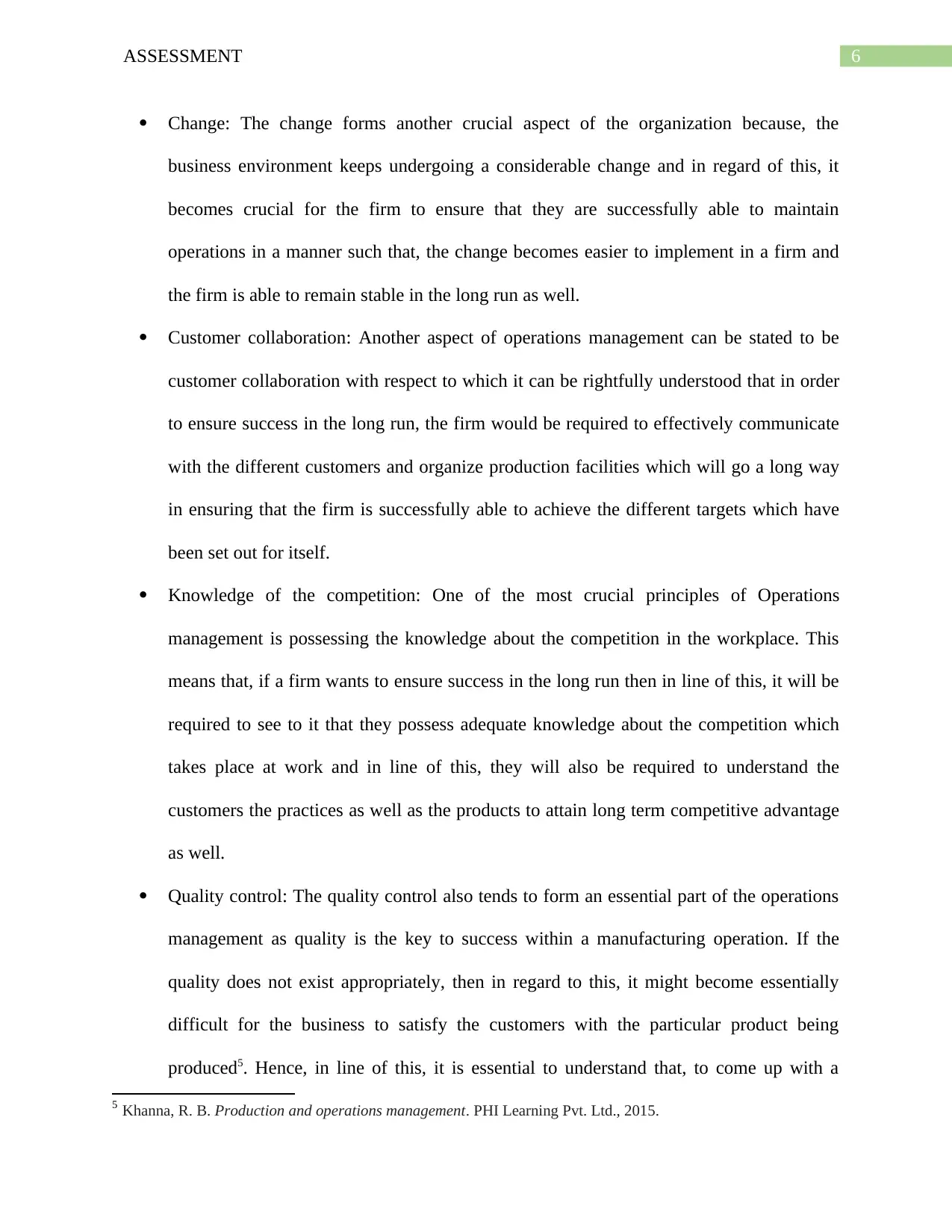
6ASSESSMENT
Change: The change forms another crucial aspect of the organization because, the
business environment keeps undergoing a considerable change and in regard of this, it
becomes crucial for the firm to ensure that they are successfully able to maintain
operations in a manner such that, the change becomes easier to implement in a firm and
the firm is able to remain stable in the long run as well.
Customer collaboration: Another aspect of operations management can be stated to be
customer collaboration with respect to which it can be rightfully understood that in order
to ensure success in the long run, the firm would be required to effectively communicate
with the different customers and organize production facilities which will go a long way
in ensuring that the firm is successfully able to achieve the different targets which have
been set out for itself.
Knowledge of the competition: One of the most crucial principles of Operations
management is possessing the knowledge about the competition in the workplace. This
means that, if a firm wants to ensure success in the long run then in line of this, it will be
required to see to it that they possess adequate knowledge about the competition which
takes place at work and in line of this, they will also be required to understand the
customers the practices as well as the products to attain long term competitive advantage
as well.
Quality control: The quality control also tends to form an essential part of the operations
management as quality is the key to success within a manufacturing operation. If the
quality does not exist appropriately, then in regard to this, it might become essentially
difficult for the business to satisfy the customers with the particular product being
produced5. Hence, in line of this, it is essential to understand that, to come up with a
5 Khanna, R. B. Production and operations management. PHI Learning Pvt. Ltd., 2015.
Change: The change forms another crucial aspect of the organization because, the
business environment keeps undergoing a considerable change and in regard of this, it
becomes crucial for the firm to ensure that they are successfully able to maintain
operations in a manner such that, the change becomes easier to implement in a firm and
the firm is able to remain stable in the long run as well.
Customer collaboration: Another aspect of operations management can be stated to be
customer collaboration with respect to which it can be rightfully understood that in order
to ensure success in the long run, the firm would be required to effectively communicate
with the different customers and organize production facilities which will go a long way
in ensuring that the firm is successfully able to achieve the different targets which have
been set out for itself.
Knowledge of the competition: One of the most crucial principles of Operations
management is possessing the knowledge about the competition in the workplace. This
means that, if a firm wants to ensure success in the long run then in line of this, it will be
required to see to it that they possess adequate knowledge about the competition which
takes place at work and in line of this, they will also be required to understand the
customers the practices as well as the products to attain long term competitive advantage
as well.
Quality control: The quality control also tends to form an essential part of the operations
management as quality is the key to success within a manufacturing operation. If the
quality does not exist appropriately, then in regard to this, it might become essentially
difficult for the business to satisfy the customers with the particular product being
produced5. Hence, in line of this, it is essential to understand that, to come up with a
5 Khanna, R. B. Production and operations management. PHI Learning Pvt. Ltd., 2015.
Secure Best Marks with AI Grader
Need help grading? Try our AI Grader for instant feedback on your assignments.
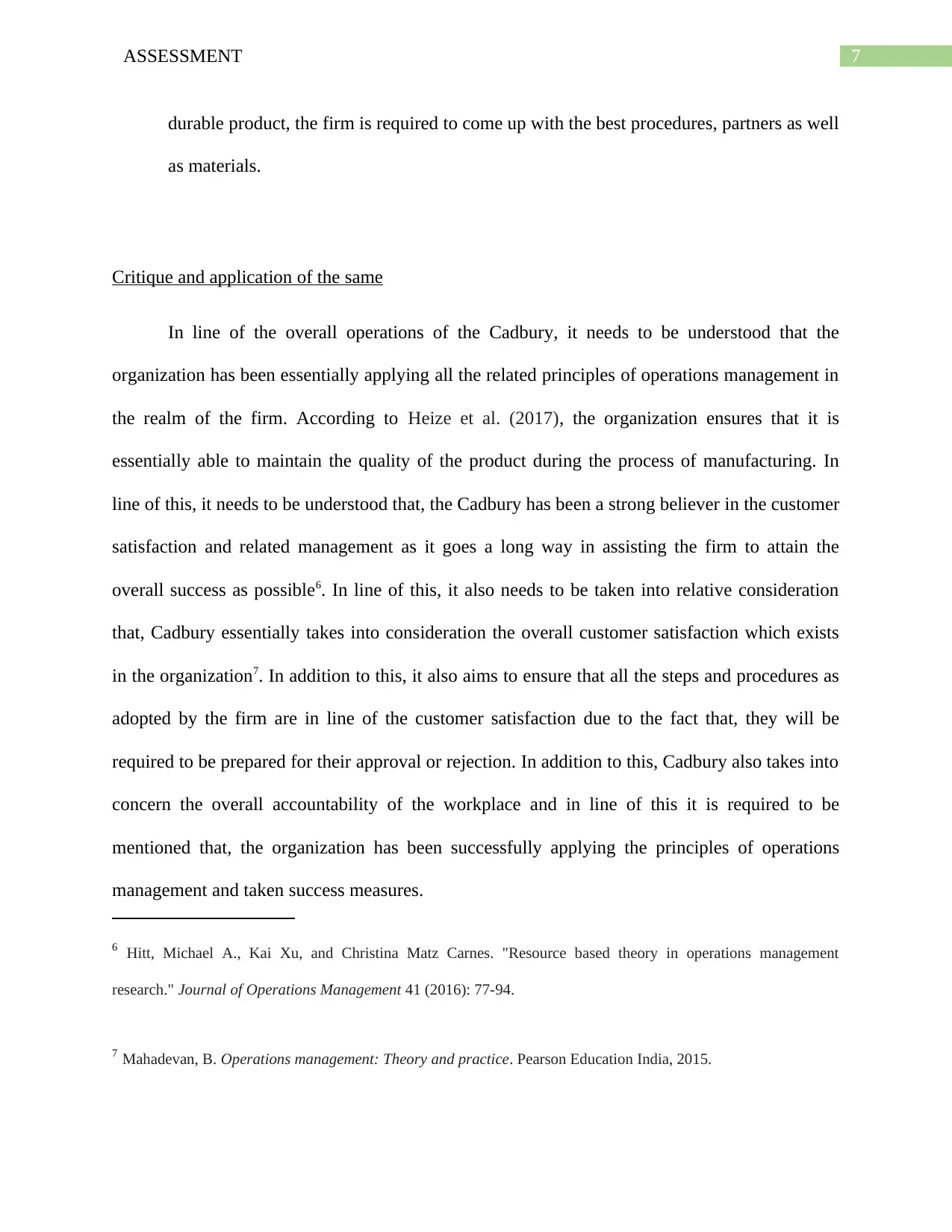
7ASSESSMENT
durable product, the firm is required to come up with the best procedures, partners as well
as materials.
Critique and application of the same
In line of the overall operations of the Cadbury, it needs to be understood that the
organization has been essentially applying all the related principles of operations management in
the realm of the firm. According to Heize et al. (2017), the organization ensures that it is
essentially able to maintain the quality of the product during the process of manufacturing. In
line of this, it needs to be understood that, the Cadbury has been a strong believer in the customer
satisfaction and related management as it goes a long way in assisting the firm to attain the
overall success as possible6. In line of this, it also needs to be taken into relative consideration
that, Cadbury essentially takes into consideration the overall customer satisfaction which exists
in the organization7. In addition to this, it also aims to ensure that all the steps and procedures as
adopted by the firm are in line of the customer satisfaction due to the fact that, they will be
required to be prepared for their approval or rejection. In addition to this, Cadbury also takes into
concern the overall accountability of the workplace and in line of this it is required to be
mentioned that, the organization has been successfully applying the principles of operations
management and taken success measures.
6 Hitt, Michael A., Kai Xu, and Christina Matz Carnes. "Resource based theory in operations management
research." Journal of Operations Management 41 (2016): 77-94.
7 Mahadevan, B. Operations management: Theory and practice. Pearson Education India, 2015.
durable product, the firm is required to come up with the best procedures, partners as well
as materials.
Critique and application of the same
In line of the overall operations of the Cadbury, it needs to be understood that the
organization has been essentially applying all the related principles of operations management in
the realm of the firm. According to Heize et al. (2017), the organization ensures that it is
essentially able to maintain the quality of the product during the process of manufacturing. In
line of this, it needs to be understood that, the Cadbury has been a strong believer in the customer
satisfaction and related management as it goes a long way in assisting the firm to attain the
overall success as possible6. In line of this, it also needs to be taken into relative consideration
that, Cadbury essentially takes into consideration the overall customer satisfaction which exists
in the organization7. In addition to this, it also aims to ensure that all the steps and procedures as
adopted by the firm are in line of the customer satisfaction due to the fact that, they will be
required to be prepared for their approval or rejection. In addition to this, Cadbury also takes into
concern the overall accountability of the workplace and in line of this it is required to be
mentioned that, the organization has been successfully applying the principles of operations
management and taken success measures.
6 Hitt, Michael A., Kai Xu, and Christina Matz Carnes. "Resource based theory in operations management
research." Journal of Operations Management 41 (2016): 77-94.
7 Mahadevan, B. Operations management: Theory and practice. Pearson Education India, 2015.
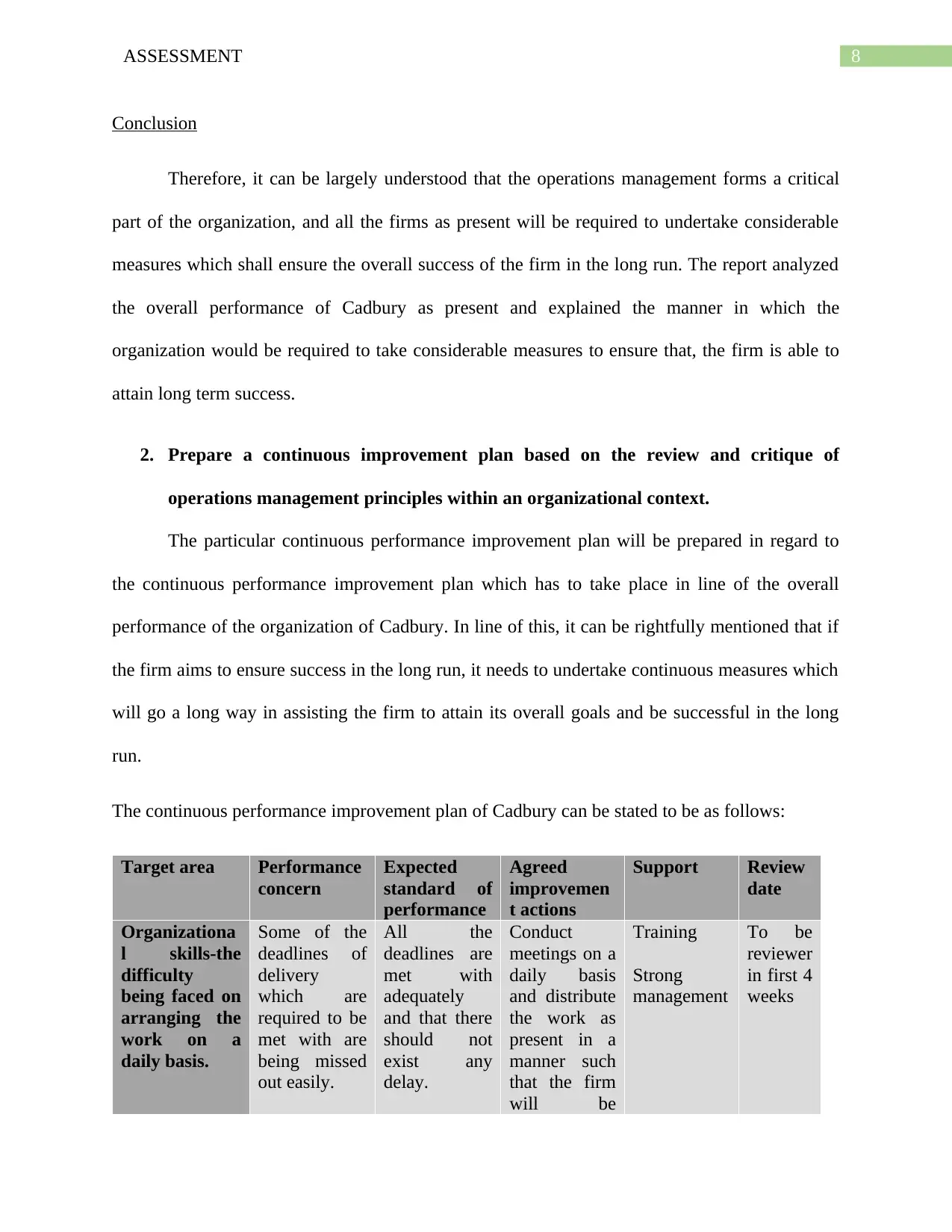
8ASSESSMENT
Conclusion
Therefore, it can be largely understood that the operations management forms a critical
part of the organization, and all the firms as present will be required to undertake considerable
measures which shall ensure the overall success of the firm in the long run. The report analyzed
the overall performance of Cadbury as present and explained the manner in which the
organization would be required to take considerable measures to ensure that, the firm is able to
attain long term success.
2. Prepare a continuous improvement plan based on the review and critique of
operations management principles within an organizational context.
The particular continuous performance improvement plan will be prepared in regard to
the continuous performance improvement plan which has to take place in line of the overall
performance of the organization of Cadbury. In line of this, it can be rightfully mentioned that if
the firm aims to ensure success in the long run, it needs to undertake continuous measures which
will go a long way in assisting the firm to attain its overall goals and be successful in the long
run.
The continuous performance improvement plan of Cadbury can be stated to be as follows:
Target area Performance
concern
Expected
standard of
performance
Agreed
improvemen
t actions
Support Review
date
Organizationa
l skills-the
difficulty
being faced on
arranging the
work on a
daily basis.
Some of the
deadlines of
delivery
which are
required to be
met with are
being missed
out easily.
All the
deadlines are
met with
adequately
and that there
should not
exist any
delay.
Conduct
meetings on a
daily basis
and distribute
the work as
present in a
manner such
that the firm
will be
Training
Strong
management
To be
reviewer
in first 4
weeks
Conclusion
Therefore, it can be largely understood that the operations management forms a critical
part of the organization, and all the firms as present will be required to undertake considerable
measures which shall ensure the overall success of the firm in the long run. The report analyzed
the overall performance of Cadbury as present and explained the manner in which the
organization would be required to take considerable measures to ensure that, the firm is able to
attain long term success.
2. Prepare a continuous improvement plan based on the review and critique of
operations management principles within an organizational context.
The particular continuous performance improvement plan will be prepared in regard to
the continuous performance improvement plan which has to take place in line of the overall
performance of the organization of Cadbury. In line of this, it can be rightfully mentioned that if
the firm aims to ensure success in the long run, it needs to undertake continuous measures which
will go a long way in assisting the firm to attain its overall goals and be successful in the long
run.
The continuous performance improvement plan of Cadbury can be stated to be as follows:
Target area Performance
concern
Expected
standard of
performance
Agreed
improvemen
t actions
Support Review
date
Organizationa
l skills-the
difficulty
being faced on
arranging the
work on a
daily basis.
Some of the
deadlines of
delivery
which are
required to be
met with are
being missed
out easily.
All the
deadlines are
met with
adequately
and that there
should not
exist any
delay.
Conduct
meetings on a
daily basis
and distribute
the work as
present in a
manner such
that the firm
will be
Training
Strong
management
To be
reviewer
in first 4
weeks
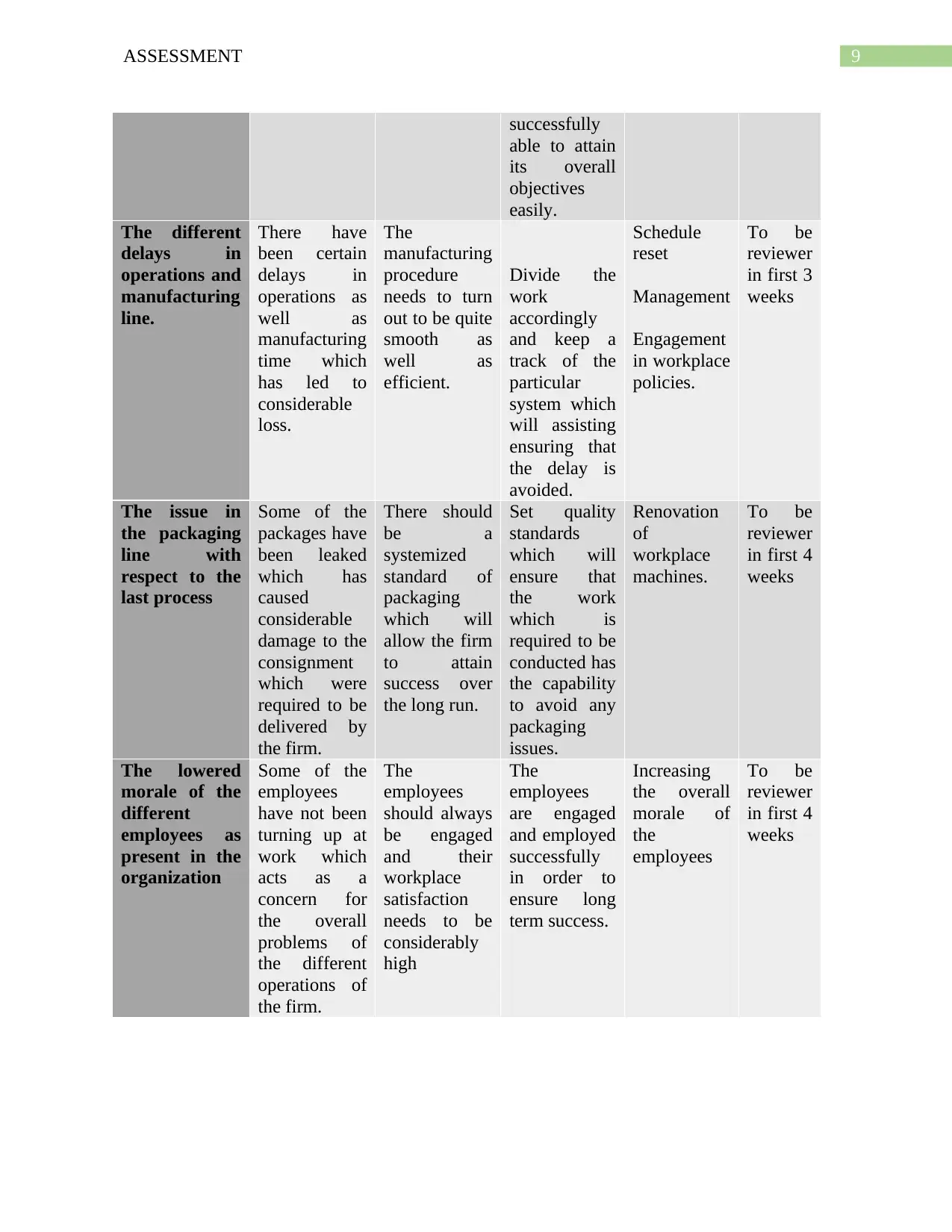
9ASSESSMENT
successfully
able to attain
its overall
objectives
easily.
The different
delays in
operations and
manufacturing
line.
There have
been certain
delays in
operations as
well as
manufacturing
time which
has led to
considerable
loss.
The
manufacturing
procedure
needs to turn
out to be quite
smooth as
well as
efficient.
Divide the
work
accordingly
and keep a
track of the
particular
system which
will assisting
ensuring that
the delay is
avoided.
Schedule
reset
Management
Engagement
in workplace
policies.
To be
reviewer
in first 3
weeks
The issue in
the packaging
line with
respect to the
last process
Some of the
packages have
been leaked
which has
caused
considerable
damage to the
consignment
which were
required to be
delivered by
the firm.
There should
be a
systemized
standard of
packaging
which will
allow the firm
to attain
success over
the long run.
Set quality
standards
which will
ensure that
the work
which is
required to be
conducted has
the capability
to avoid any
packaging
issues.
Renovation
of
workplace
machines.
To be
reviewer
in first 4
weeks
The lowered
morale of the
different
employees as
present in the
organization
Some of the
employees
have not been
turning up at
work which
acts as a
concern for
the overall
problems of
the different
operations of
the firm.
The
employees
should always
be engaged
and their
workplace
satisfaction
needs to be
considerably
high
The
employees
are engaged
and employed
successfully
in order to
ensure long
term success.
Increasing
the overall
morale of
the
employees
To be
reviewer
in first 4
weeks
successfully
able to attain
its overall
objectives
easily.
The different
delays in
operations and
manufacturing
line.
There have
been certain
delays in
operations as
well as
manufacturing
time which
has led to
considerable
loss.
The
manufacturing
procedure
needs to turn
out to be quite
smooth as
well as
efficient.
Divide the
work
accordingly
and keep a
track of the
particular
system which
will assisting
ensuring that
the delay is
avoided.
Schedule
reset
Management
Engagement
in workplace
policies.
To be
reviewer
in first 3
weeks
The issue in
the packaging
line with
respect to the
last process
Some of the
packages have
been leaked
which has
caused
considerable
damage to the
consignment
which were
required to be
delivered by
the firm.
There should
be a
systemized
standard of
packaging
which will
allow the firm
to attain
success over
the long run.
Set quality
standards
which will
ensure that
the work
which is
required to be
conducted has
the capability
to avoid any
packaging
issues.
Renovation
of
workplace
machines.
To be
reviewer
in first 4
weeks
The lowered
morale of the
different
employees as
present in the
organization
Some of the
employees
have not been
turning up at
work which
acts as a
concern for
the overall
problems of
the different
operations of
the firm.
The
employees
should always
be engaged
and their
workplace
satisfaction
needs to be
considerably
high
The
employees
are engaged
and employed
successfully
in order to
ensure long
term success.
Increasing
the overall
morale of
the
employees
To be
reviewer
in first 4
weeks
Paraphrase This Document
Need a fresh take? Get an instant paraphrase of this document with our AI Paraphraser
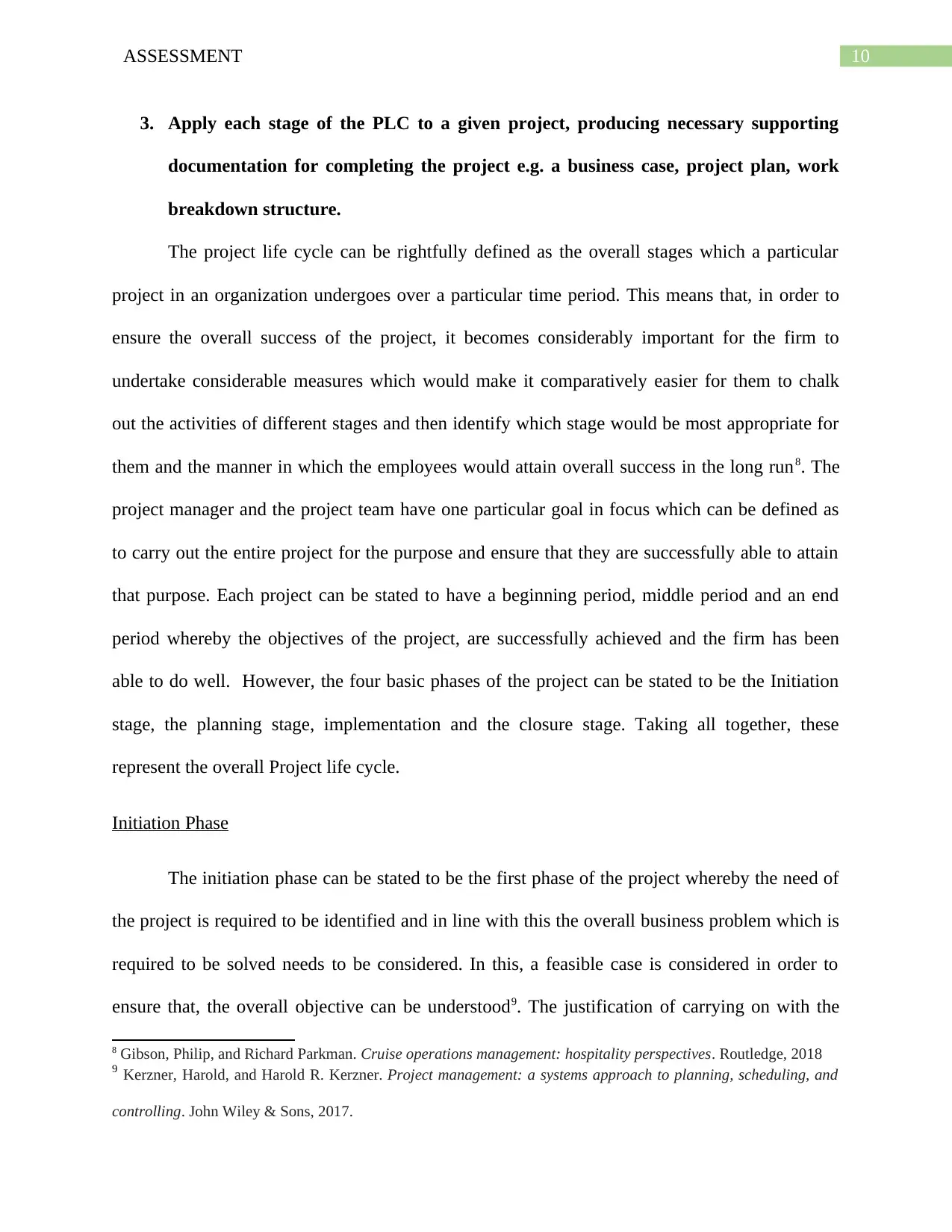
10ASSESSMENT
3. Apply each stage of the PLC to a given project, producing necessary supporting
documentation for completing the project e.g. a business case, project plan, work
breakdown structure.
The project life cycle can be rightfully defined as the overall stages which a particular
project in an organization undergoes over a particular time period. This means that, in order to
ensure the overall success of the project, it becomes considerably important for the firm to
undertake considerable measures which would make it comparatively easier for them to chalk
out the activities of different stages and then identify which stage would be most appropriate for
them and the manner in which the employees would attain overall success in the long run8. The
project manager and the project team have one particular goal in focus which can be defined as
to carry out the entire project for the purpose and ensure that they are successfully able to attain
that purpose. Each project can be stated to have a beginning period, middle period and an end
period whereby the objectives of the project, are successfully achieved and the firm has been
able to do well. However, the four basic phases of the project can be stated to be the Initiation
stage, the planning stage, implementation and the closure stage. Taking all together, these
represent the overall Project life cycle.
Initiation Phase
The initiation phase can be stated to be the first phase of the project whereby the need of
the project is required to be identified and in line with this the overall business problem which is
required to be solved needs to be considered. In this, a feasible case is considered in order to
ensure that, the overall objective can be understood9. The justification of carrying on with the
8 Gibson, Philip, and Richard Parkman. Cruise operations management: hospitality perspectives. Routledge, 2018
9 Kerzner, Harold, and Harold R. Kerzner. Project management: a systems approach to planning, scheduling, and
controlling. John Wiley & Sons, 2017.
3. Apply each stage of the PLC to a given project, producing necessary supporting
documentation for completing the project e.g. a business case, project plan, work
breakdown structure.
The project life cycle can be rightfully defined as the overall stages which a particular
project in an organization undergoes over a particular time period. This means that, in order to
ensure the overall success of the project, it becomes considerably important for the firm to
undertake considerable measures which would make it comparatively easier for them to chalk
out the activities of different stages and then identify which stage would be most appropriate for
them and the manner in which the employees would attain overall success in the long run8. The
project manager and the project team have one particular goal in focus which can be defined as
to carry out the entire project for the purpose and ensure that they are successfully able to attain
that purpose. Each project can be stated to have a beginning period, middle period and an end
period whereby the objectives of the project, are successfully achieved and the firm has been
able to do well. However, the four basic phases of the project can be stated to be the Initiation
stage, the planning stage, implementation and the closure stage. Taking all together, these
represent the overall Project life cycle.
Initiation Phase
The initiation phase can be stated to be the first phase of the project whereby the need of
the project is required to be identified and in line with this the overall business problem which is
required to be solved needs to be considered. In this, a feasible case is considered in order to
ensure that, the overall objective can be understood9. The justification of carrying on with the
8 Gibson, Philip, and Richard Parkman. Cruise operations management: hospitality perspectives. Routledge, 2018
9 Kerzner, Harold, and Harold R. Kerzner. Project management: a systems approach to planning, scheduling, and
controlling. John Wiley & Sons, 2017.
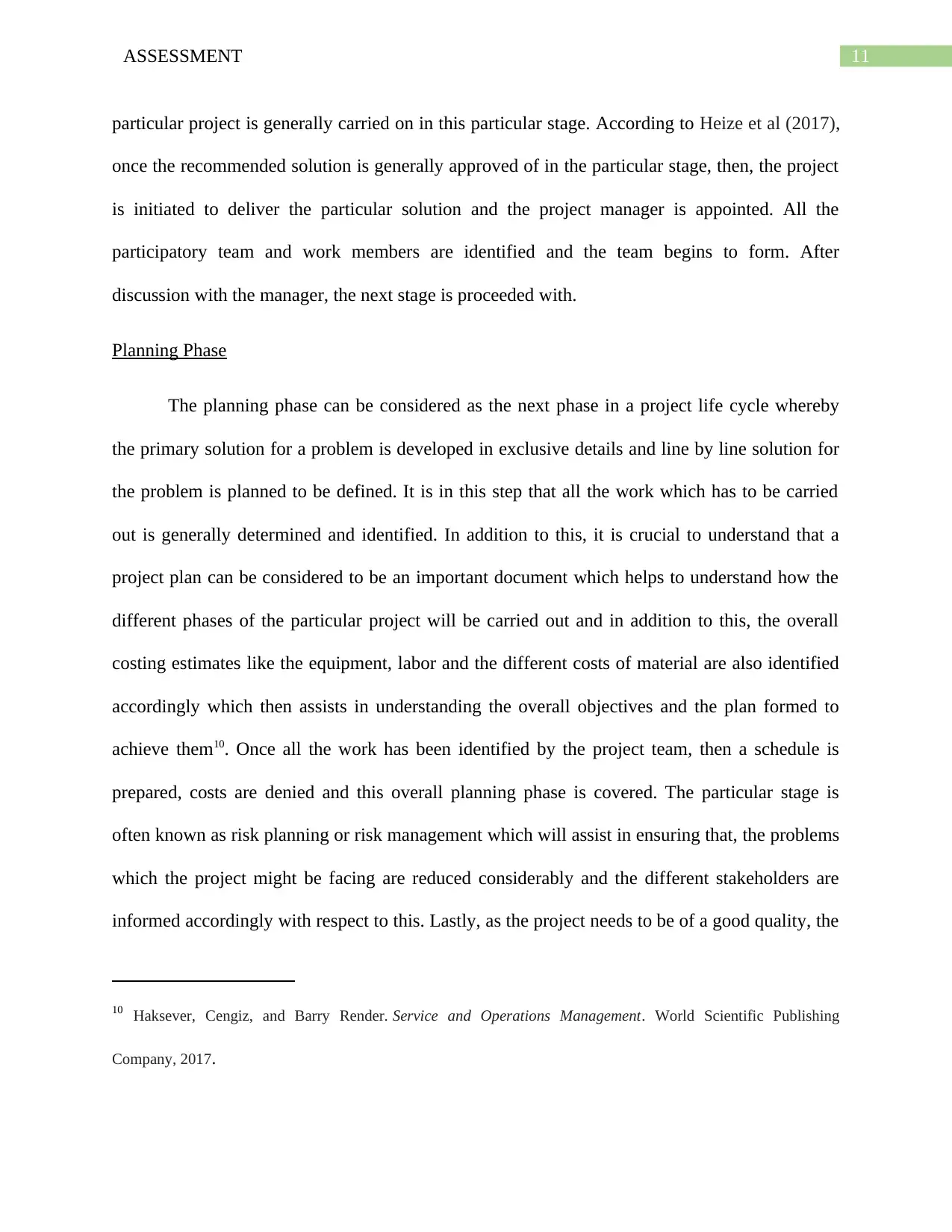
11ASSESSMENT
particular project is generally carried on in this particular stage. According to Heize et al (2017),
once the recommended solution is generally approved of in the particular stage, then, the project
is initiated to deliver the particular solution and the project manager is appointed. All the
participatory team and work members are identified and the team begins to form. After
discussion with the manager, the next stage is proceeded with.
Planning Phase
The planning phase can be considered as the next phase in a project life cycle whereby
the primary solution for a problem is developed in exclusive details and line by line solution for
the problem is planned to be defined. It is in this step that all the work which has to be carried
out is generally determined and identified. In addition to this, it is crucial to understand that a
project plan can be considered to be an important document which helps to understand how the
different phases of the particular project will be carried out and in addition to this, the overall
costing estimates like the equipment, labor and the different costs of material are also identified
accordingly which then assists in understanding the overall objectives and the plan formed to
achieve them10. Once all the work has been identified by the project team, then a schedule is
prepared, costs are denied and this overall planning phase is covered. The particular stage is
often known as risk planning or risk management which will assist in ensuring that, the problems
which the project might be facing are reduced considerably and the different stakeholders are
informed accordingly with respect to this. Lastly, as the project needs to be of a good quality, the
10 Haksever, Cengiz, and Barry Render. Service and Operations Management. World Scientific Publishing
Company, 2017.
particular project is generally carried on in this particular stage. According to Heize et al (2017),
once the recommended solution is generally approved of in the particular stage, then, the project
is initiated to deliver the particular solution and the project manager is appointed. All the
participatory team and work members are identified and the team begins to form. After
discussion with the manager, the next stage is proceeded with.
Planning Phase
The planning phase can be considered as the next phase in a project life cycle whereby
the primary solution for a problem is developed in exclusive details and line by line solution for
the problem is planned to be defined. It is in this step that all the work which has to be carried
out is generally determined and identified. In addition to this, it is crucial to understand that a
project plan can be considered to be an important document which helps to understand how the
different phases of the particular project will be carried out and in addition to this, the overall
costing estimates like the equipment, labor and the different costs of material are also identified
accordingly which then assists in understanding the overall objectives and the plan formed to
achieve them10. Once all the work has been identified by the project team, then a schedule is
prepared, costs are denied and this overall planning phase is covered. The particular stage is
often known as risk planning or risk management which will assist in ensuring that, the problems
which the project might be facing are reduced considerably and the different stakeholders are
informed accordingly with respect to this. Lastly, as the project needs to be of a good quality, the
10 Haksever, Cengiz, and Barry Render. Service and Operations Management. World Scientific Publishing
Company, 2017.

12ASSESSMENT
quality targets, assurance and related control measures are also identified so as to ensure that all
the planning takes place accordingly.
Implementation (Execution) Phase
The third stage in the project life cycle can be understood to be the implementation phase
whereby the project is actually put into motion and the main work of the project is performed. In
this stage, it becomes considerably important to maintain the specific control as very often the
work may not be as appropriate as the overall plan which well be scheduled. The progress is also
continuously monitored in order to ensure that, there does not take place any variation from the
set target. Additionally, it also becomes important to ensure that the firm is successfully able to
hold regular meetings, meet with their short term deadline and keep record of the variations with
them. This will later help them to ensure that they do not get stuck with any possible issues
which might tamper their overall success11. The status reports form a crucial aspect of the
different plans and it can be stated to be the overall duty of the organization to ensure that, they
are updating the rest of the firm about their progress with respect to the overall project and that
the final solution is being achieved successfully.
Closing Phase
The closing phase is often known as a crucial stage whereby, the organization would be
required to ensure that, they ensure that the different targets which the firm laid out for itself
have been achieved successfully and that, all the supplier contracts, project reports and other
relevant details are released accordingly. Lastly, the variations need to be filled which shall assist
in ensuring future success.
11 Heagney, Joseph. Fundamentals of project management. Amacom, 2016.
quality targets, assurance and related control measures are also identified so as to ensure that all
the planning takes place accordingly.
Implementation (Execution) Phase
The third stage in the project life cycle can be understood to be the implementation phase
whereby the project is actually put into motion and the main work of the project is performed. In
this stage, it becomes considerably important to maintain the specific control as very often the
work may not be as appropriate as the overall plan which well be scheduled. The progress is also
continuously monitored in order to ensure that, there does not take place any variation from the
set target. Additionally, it also becomes important to ensure that the firm is successfully able to
hold regular meetings, meet with their short term deadline and keep record of the variations with
them. This will later help them to ensure that they do not get stuck with any possible issues
which might tamper their overall success11. The status reports form a crucial aspect of the
different plans and it can be stated to be the overall duty of the organization to ensure that, they
are updating the rest of the firm about their progress with respect to the overall project and that
the final solution is being achieved successfully.
Closing Phase
The closing phase is often known as a crucial stage whereby, the organization would be
required to ensure that, they ensure that the different targets which the firm laid out for itself
have been achieved successfully and that, all the supplier contracts, project reports and other
relevant details are released accordingly. Lastly, the variations need to be filled which shall assist
in ensuring future success.
11 Heagney, Joseph. Fundamentals of project management. Amacom, 2016.
Secure Best Marks with AI Grader
Need help grading? Try our AI Grader for instant feedback on your assignments.
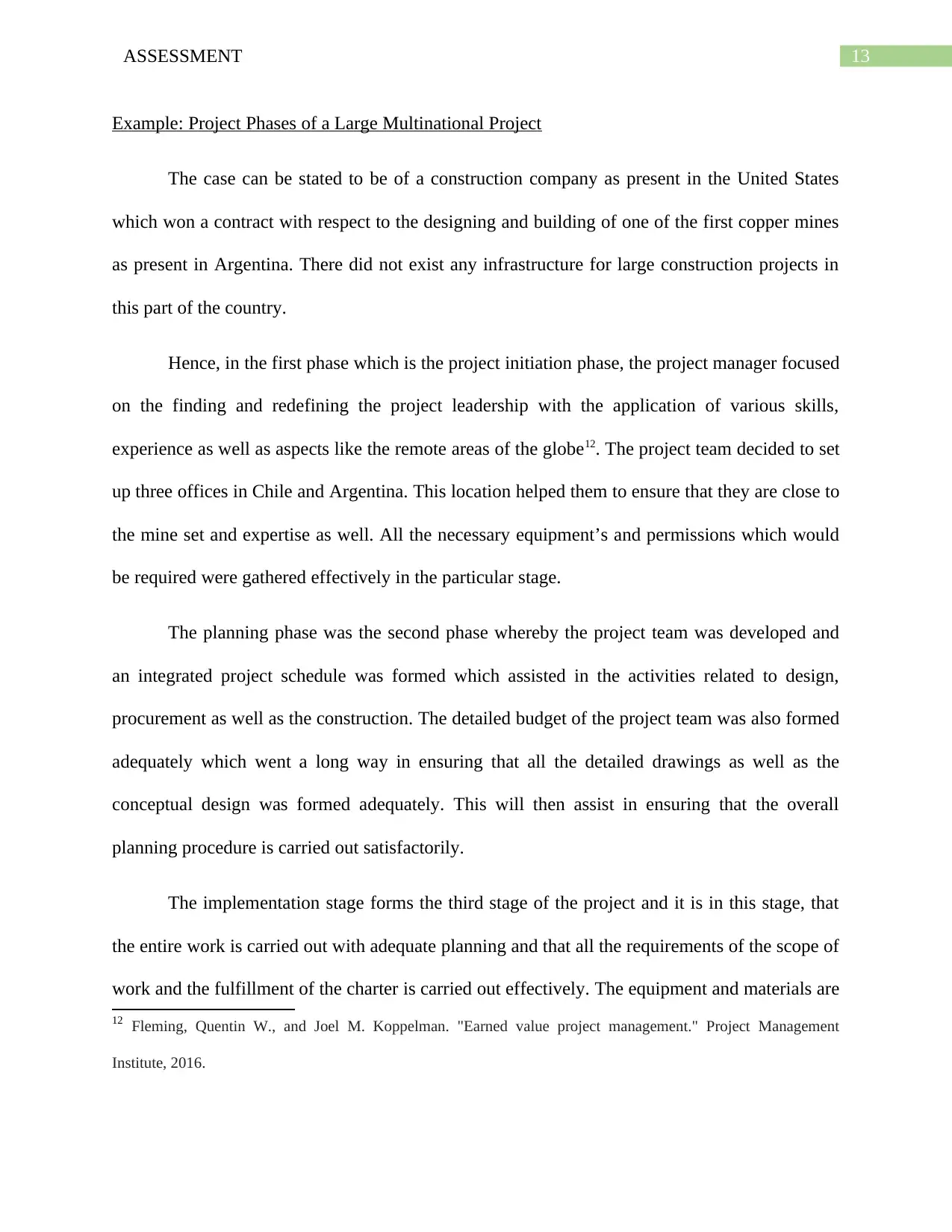
13ASSESSMENT
Example: Project Phases of a Large Multinational Project
The case can be stated to be of a construction company as present in the United States
which won a contract with respect to the designing and building of one of the first copper mines
as present in Argentina. There did not exist any infrastructure for large construction projects in
this part of the country.
Hence, in the first phase which is the project initiation phase, the project manager focused
on the finding and redefining the project leadership with the application of various skills,
experience as well as aspects like the remote areas of the globe12. The project team decided to set
up three offices in Chile and Argentina. This location helped them to ensure that they are close to
the mine set and expertise as well. All the necessary equipment’s and permissions which would
be required were gathered effectively in the particular stage.
The planning phase was the second phase whereby the project team was developed and
an integrated project schedule was formed which assisted in the activities related to design,
procurement as well as the construction. The detailed budget of the project team was also formed
adequately which went a long way in ensuring that all the detailed drawings as well as the
conceptual design was formed adequately. This will then assist in ensuring that the overall
planning procedure is carried out satisfactorily.
The implementation stage forms the third stage of the project and it is in this stage, that
the entire work is carried out with adequate planning and that all the requirements of the scope of
work and the fulfillment of the charter is carried out effectively. The equipment and materials are
12 Fleming, Quentin W., and Joel M. Koppelman. "Earned value project management." Project Management
Institute, 2016.
Example: Project Phases of a Large Multinational Project
The case can be stated to be of a construction company as present in the United States
which won a contract with respect to the designing and building of one of the first copper mines
as present in Argentina. There did not exist any infrastructure for large construction projects in
this part of the country.
Hence, in the first phase which is the project initiation phase, the project manager focused
on the finding and redefining the project leadership with the application of various skills,
experience as well as aspects like the remote areas of the globe12. The project team decided to set
up three offices in Chile and Argentina. This location helped them to ensure that they are close to
the mine set and expertise as well. All the necessary equipment’s and permissions which would
be required were gathered effectively in the particular stage.
The planning phase was the second phase whereby the project team was developed and
an integrated project schedule was formed which assisted in the activities related to design,
procurement as well as the construction. The detailed budget of the project team was also formed
adequately which went a long way in ensuring that all the detailed drawings as well as the
conceptual design was formed adequately. This will then assist in ensuring that the overall
planning procedure is carried out satisfactorily.
The implementation stage forms the third stage of the project and it is in this stage, that
the entire work is carried out with adequate planning and that all the requirements of the scope of
work and the fulfillment of the charter is carried out effectively. The equipment and materials are
12 Fleming, Quentin W., and Joel M. Koppelman. "Earned value project management." Project Management
Institute, 2016.

14ASSESSMENT
delivered to the particular work site and the labor is highly trained and hired from expert
institutions in order to ensure that when the construction site is built, all the construction
activities can be easily, carried out and the installation of the first dozer to the final switch was
completed.
The last phase which is known as the closeout phase is generally understood to be a phase
with respect to which, all the remaining work is completed and the overall procedure is
documented successfully. In addition to this, the project team is often dismissed in order to give
space to the new teams as present.
Hence, from the given section, it was critically understood that, the Project life cycle can
be understood to be a complicated procedure which comprises of four different phases which are
generally same in all projects. These phases ensure that the entire project can be successfully be
completed on time and in addition to this, the overall objectives and goals of the team can also be
attained.
4. Review and critique the effectiveness of the PLC in application to the chosen project
using appropriate theories, concepts and models.
From the previous section, it was understood that a Project Lifecycle rightfully comprises
of different aspects like the Initiation, Planning, the Implementation stage and the phase out
stage. However, in this section of the report the overall appropriation of the project would be
rightfully understood with respect to the different theories, concepts as well as the models as
present13. The different benefits of the lifecycle can be stated to be as follows:
13 Lu, Guanyi, et al. "Addressing endogeneity in operations management research: Recent developments, common
problems, and directions for future research." Journal of Operations Management (2018).
delivered to the particular work site and the labor is highly trained and hired from expert
institutions in order to ensure that when the construction site is built, all the construction
activities can be easily, carried out and the installation of the first dozer to the final switch was
completed.
The last phase which is known as the closeout phase is generally understood to be a phase
with respect to which, all the remaining work is completed and the overall procedure is
documented successfully. In addition to this, the project team is often dismissed in order to give
space to the new teams as present.
Hence, from the given section, it was critically understood that, the Project life cycle can
be understood to be a complicated procedure which comprises of four different phases which are
generally same in all projects. These phases ensure that the entire project can be successfully be
completed on time and in addition to this, the overall objectives and goals of the team can also be
attained.
4. Review and critique the effectiveness of the PLC in application to the chosen project
using appropriate theories, concepts and models.
From the previous section, it was understood that a Project Lifecycle rightfully comprises
of different aspects like the Initiation, Planning, the Implementation stage and the phase out
stage. However, in this section of the report the overall appropriation of the project would be
rightfully understood with respect to the different theories, concepts as well as the models as
present13. The different benefits of the lifecycle can be stated to be as follows:
13 Lu, Guanyi, et al. "Addressing endogeneity in operations management research: Recent developments, common
problems, and directions for future research." Journal of Operations Management (2018).
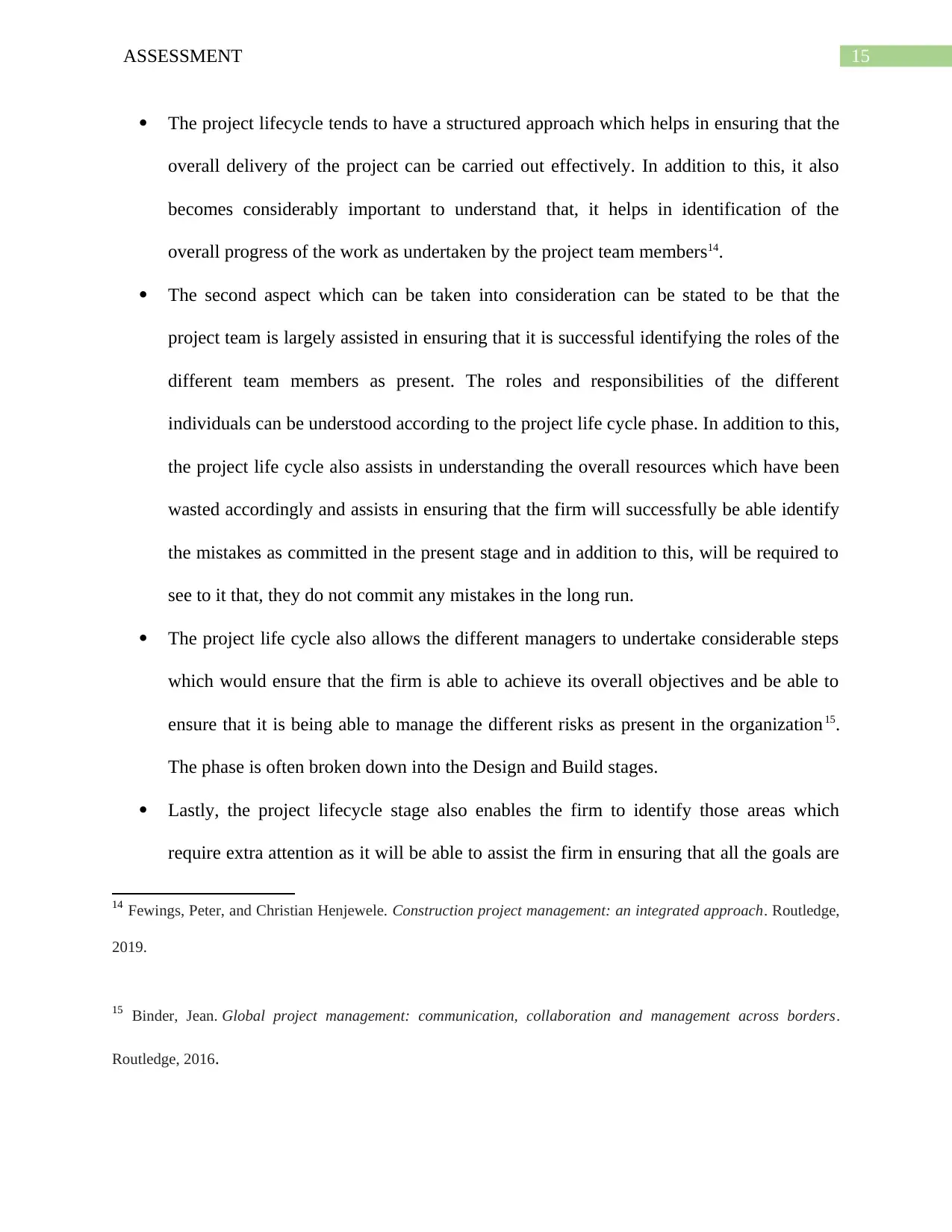
15ASSESSMENT
The project lifecycle tends to have a structured approach which helps in ensuring that the
overall delivery of the project can be carried out effectively. In addition to this, it also
becomes considerably important to understand that, it helps in identification of the
overall progress of the work as undertaken by the project team members14.
The second aspect which can be taken into consideration can be stated to be that the
project team is largely assisted in ensuring that it is successful identifying the roles of the
different team members as present. The roles and responsibilities of the different
individuals can be understood according to the project life cycle phase. In addition to this,
the project life cycle also assists in understanding the overall resources which have been
wasted accordingly and assists in ensuring that the firm will successfully be able identify
the mistakes as committed in the present stage and in addition to this, will be required to
see to it that, they do not commit any mistakes in the long run.
The project life cycle also allows the different managers to undertake considerable steps
which would ensure that the firm is able to achieve its overall objectives and be able to
ensure that it is being able to manage the different risks as present in the organization 15.
The phase is often broken down into the Design and Build stages.
Lastly, the project lifecycle stage also enables the firm to identify those areas which
require extra attention as it will be able to assist the firm in ensuring that all the goals are
14 Fewings, Peter, and Christian Henjewele. Construction project management: an integrated approach. Routledge,
2019.
15 Binder, Jean. Global project management: communication, collaboration and management across borders.
Routledge, 2016.
The project lifecycle tends to have a structured approach which helps in ensuring that the
overall delivery of the project can be carried out effectively. In addition to this, it also
becomes considerably important to understand that, it helps in identification of the
overall progress of the work as undertaken by the project team members14.
The second aspect which can be taken into consideration can be stated to be that the
project team is largely assisted in ensuring that it is successful identifying the roles of the
different team members as present. The roles and responsibilities of the different
individuals can be understood according to the project life cycle phase. In addition to this,
the project life cycle also assists in understanding the overall resources which have been
wasted accordingly and assists in ensuring that the firm will successfully be able identify
the mistakes as committed in the present stage and in addition to this, will be required to
see to it that, they do not commit any mistakes in the long run.
The project life cycle also allows the different managers to undertake considerable steps
which would ensure that the firm is able to achieve its overall objectives and be able to
ensure that it is being able to manage the different risks as present in the organization 15.
The phase is often broken down into the Design and Build stages.
Lastly, the project lifecycle stage also enables the firm to identify those areas which
require extra attention as it will be able to assist the firm in ensuring that all the goals are
14 Fewings, Peter, and Christian Henjewele. Construction project management: an integrated approach. Routledge,
2019.
15 Binder, Jean. Global project management: communication, collaboration and management across borders.
Routledge, 2016.
Paraphrase This Document
Need a fresh take? Get an instant paraphrase of this document with our AI Paraphraser

16ASSESSMENT
achieved successfully and in addition to this, they would also be required to ensure that
they are successfully able to go through the Project evaluation review and other Gate
Reviews stage. Hence, this will ensure that the project manager, is able to identify the
Project evaluation review and Gate review which will ensure successful completion of
goals as well as objectives.
Hence, from the given section, it can be rightfully understood that, in the above discussed
project as undertaken by the United States multinational company, it was identified that, the
project was able to find long term success with respect to the fact that it went through a proper
cycle which identified the different stages which existed and in addition to this, was also able to
understand the utilization of different resources which exist due to the fact that, during the last
closing stage, the firm was successfully able to determine the left overs and considerable steps
which had to be undertaken in the coming stage.
achieved successfully and in addition to this, they would also be required to ensure that
they are successfully able to go through the Project evaluation review and other Gate
Reviews stage. Hence, this will ensure that the project manager, is able to identify the
Project evaluation review and Gate review which will ensure successful completion of
goals as well as objectives.
Hence, from the given section, it can be rightfully understood that, in the above discussed
project as undertaken by the United States multinational company, it was identified that, the
project was able to find long term success with respect to the fact that it went through a proper
cycle which identified the different stages which existed and in addition to this, was also able to
understand the utilization of different resources which exist due to the fact that, during the last
closing stage, the firm was successfully able to determine the left overs and considerable steps
which had to be undertaken in the coming stage.
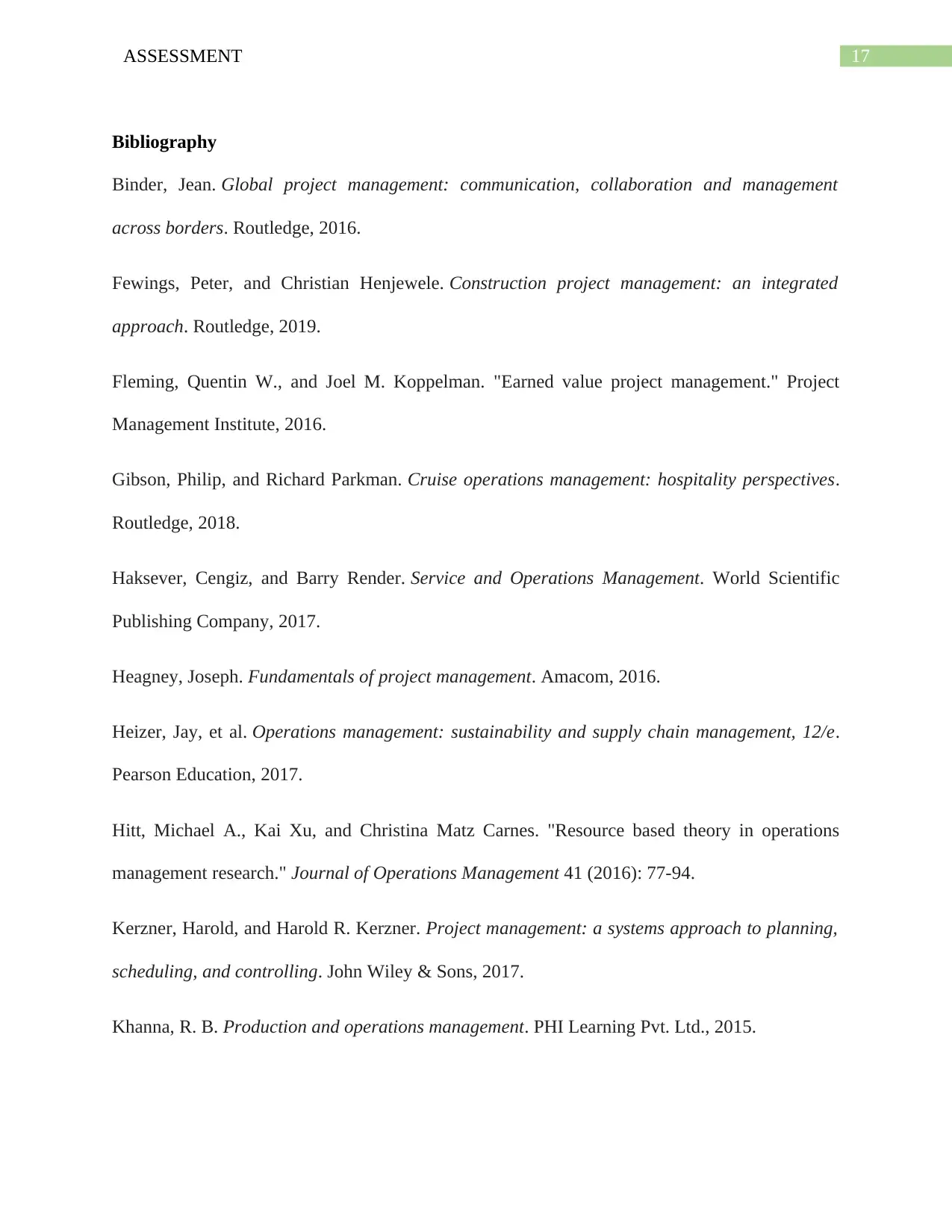
17ASSESSMENT
Bibliography
Binder, Jean. Global project management: communication, collaboration and management
across borders. Routledge, 2016.
Fewings, Peter, and Christian Henjewele. Construction project management: an integrated
approach. Routledge, 2019.
Fleming, Quentin W., and Joel M. Koppelman. "Earned value project management." Project
Management Institute, 2016.
Gibson, Philip, and Richard Parkman. Cruise operations management: hospitality perspectives.
Routledge, 2018.
Haksever, Cengiz, and Barry Render. Service and Operations Management. World Scientific
Publishing Company, 2017.
Heagney, Joseph. Fundamentals of project management. Amacom, 2016.
Heizer, Jay, et al. Operations management: sustainability and supply chain management, 12/e.
Pearson Education, 2017.
Hitt, Michael A., Kai Xu, and Christina Matz Carnes. "Resource based theory in operations
management research." Journal of Operations Management 41 (2016): 77-94.
Kerzner, Harold, and Harold R. Kerzner. Project management: a systems approach to planning,
scheduling, and controlling. John Wiley & Sons, 2017.
Khanna, R. B. Production and operations management. PHI Learning Pvt. Ltd., 2015.
Bibliography
Binder, Jean. Global project management: communication, collaboration and management
across borders. Routledge, 2016.
Fewings, Peter, and Christian Henjewele. Construction project management: an integrated
approach. Routledge, 2019.
Fleming, Quentin W., and Joel M. Koppelman. "Earned value project management." Project
Management Institute, 2016.
Gibson, Philip, and Richard Parkman. Cruise operations management: hospitality perspectives.
Routledge, 2018.
Haksever, Cengiz, and Barry Render. Service and Operations Management. World Scientific
Publishing Company, 2017.
Heagney, Joseph. Fundamentals of project management. Amacom, 2016.
Heizer, Jay, et al. Operations management: sustainability and supply chain management, 12/e.
Pearson Education, 2017.
Hitt, Michael A., Kai Xu, and Christina Matz Carnes. "Resource based theory in operations
management research." Journal of Operations Management 41 (2016): 77-94.
Kerzner, Harold, and Harold R. Kerzner. Project management: a systems approach to planning,
scheduling, and controlling. John Wiley & Sons, 2017.
Khanna, R. B. Production and operations management. PHI Learning Pvt. Ltd., 2015.
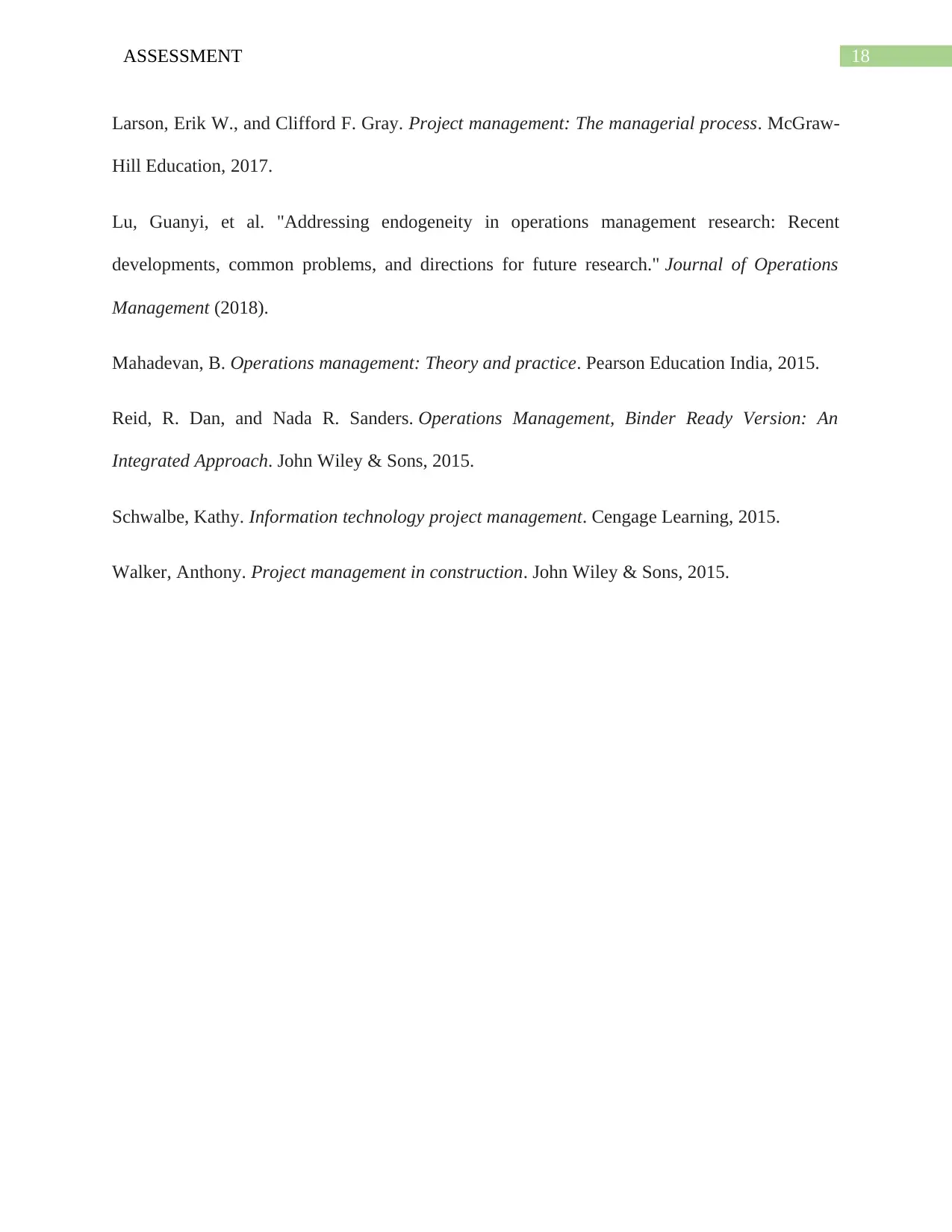
18ASSESSMENT
Larson, Erik W., and Clifford F. Gray. Project management: The managerial process. McGraw-
Hill Education, 2017.
Lu, Guanyi, et al. "Addressing endogeneity in operations management research: Recent
developments, common problems, and directions for future research." Journal of Operations
Management (2018).
Mahadevan, B. Operations management: Theory and practice. Pearson Education India, 2015.
Reid, R. Dan, and Nada R. Sanders. Operations Management, Binder Ready Version: An
Integrated Approach. John Wiley & Sons, 2015.
Schwalbe, Kathy. Information technology project management. Cengage Learning, 2015.
Walker, Anthony. Project management in construction. John Wiley & Sons, 2015.
Larson, Erik W., and Clifford F. Gray. Project management: The managerial process. McGraw-
Hill Education, 2017.
Lu, Guanyi, et al. "Addressing endogeneity in operations management research: Recent
developments, common problems, and directions for future research." Journal of Operations
Management (2018).
Mahadevan, B. Operations management: Theory and practice. Pearson Education India, 2015.
Reid, R. Dan, and Nada R. Sanders. Operations Management, Binder Ready Version: An
Integrated Approach. John Wiley & Sons, 2015.
Schwalbe, Kathy. Information technology project management. Cengage Learning, 2015.
Walker, Anthony. Project management in construction. John Wiley & Sons, 2015.
1 out of 19
![[object Object]](/_next/static/media/star-bottom.7253800d.svg)





